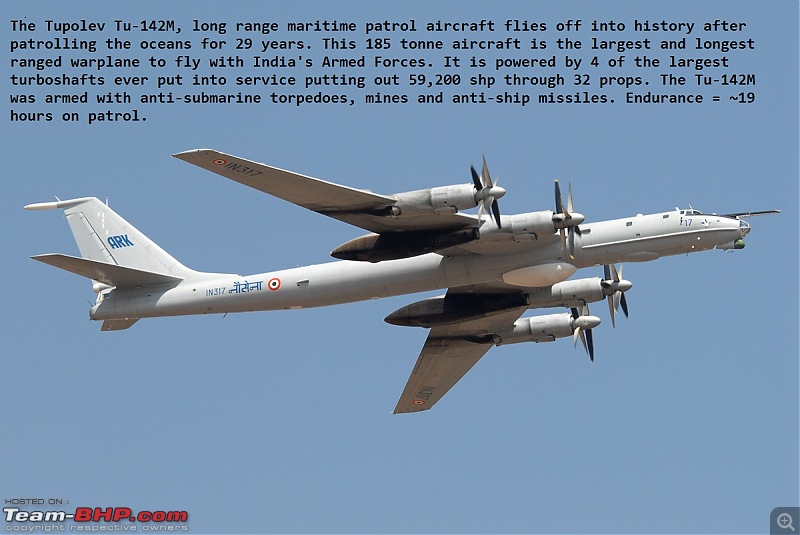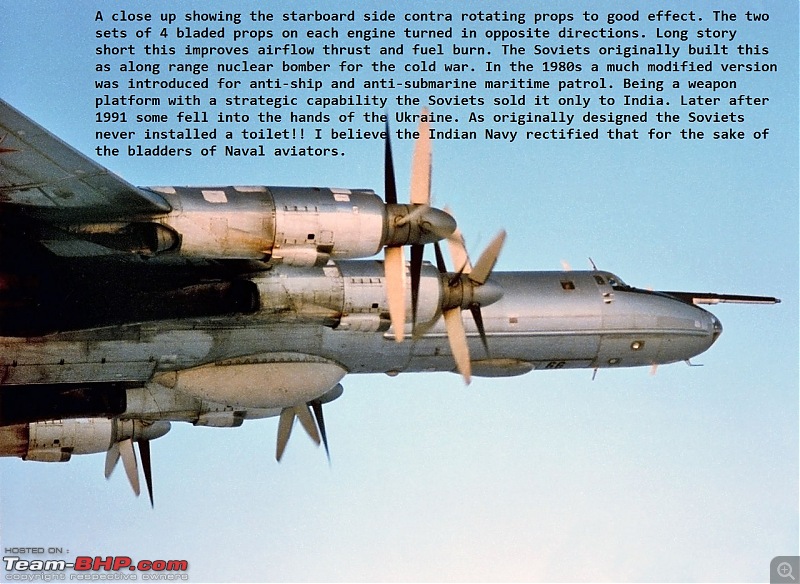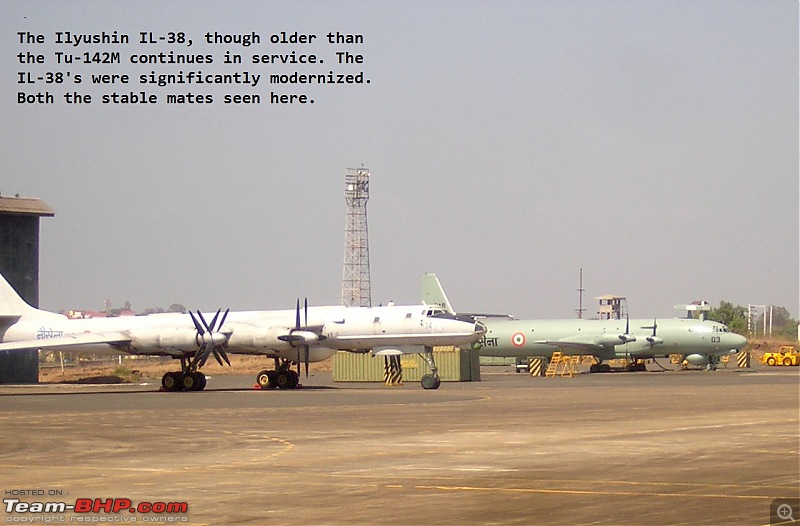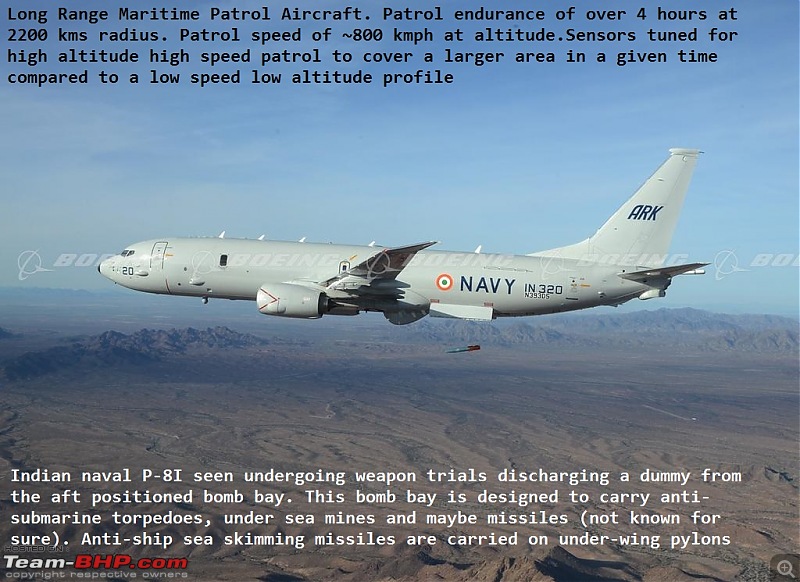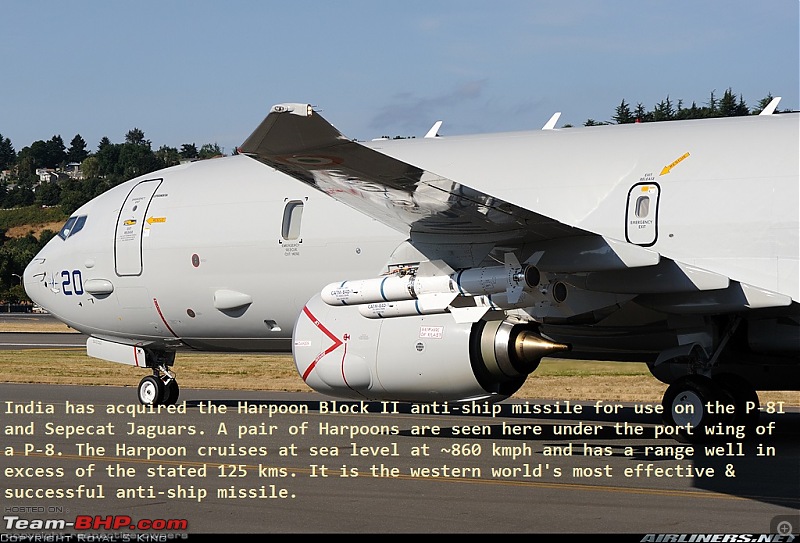Team-BHP
(
https://www.team-bhp.com/forum/)
Quote:
Originally Posted by V.Narayan
(Post 4162355)
No other country uses the US-2 because this will be the first ever sale of any military hardware by Japan.
|
Which does not testify the product capability.
In fact, buying any product which isn't popular only poses challenges to any purchaser. The reasons do not matter, the implications are the same.
Quote:
Originally Posted by V.Narayan
(Post 4173541)
In theory the aircraft could have flown on for another 5 to 8 years but I suspect availability of spares support from Russia may have been a factor in its retirement. Sadly the days of unquestioning Indo-Soviet friendship which my generation assumed as a given are now history.
|
Lovely post Mr Narayan, as always!
A retired Wing Commander of the IAF (who had also been ADC to the Chief of Air Staff twice in his career) had once told me that even at the height of the so-called Indo-Soviet friendship, getting spares for Soviet equipment was a pain in the neck! He told me that they had to literally beg for spares. It was hardly a friendship.
Perhaps the only advantage of Soviet equipment was that it cost very little, which of course was offset by poor serviceability.
Coming to Tu 142 and P8 comparison, don't you think P8 has much shorter range and endurance? P8 seems to belong to Il 38 class.
Quote:
Originally Posted by directinjection
(Post 4174188)
Lovely post Mr Narayan, as always!
..... that even at the height of the so-called Indo-Soviet friendship, getting spares for Soviet equipment was a pain in the neck!
Perhaps the only advantage of Soviet equipment was that it cost very little, which of course was offset by poor serviceability.
Coming to Tu 142 and P8 comparison, don't you think P8 has much shorter range and endurance? P8 seems to belong to Il 38 class.
|
Thank you for your kind words. You are correct that spares were a challenge even in the days of friendship. Not because of mal-intention on part of the Soviets but that their system of planning and ordering worked in 5 year plans while ours was (like most countries) 12 months out at best. Also the Soviet systems minimum order quantities were too large for us and their system did not have the flexibility to build and sell in small quantities. The Navy solved it best by forming a joint working group which worked very well especially from mid-1970s onwards. In this Admiral Gorshkov (the father of the Soviet Navy) played a big role. He had a soft spot for the Indian Navy and that lent flexibility to the relationship. On the other hand the Soviets passed on the know-how for maintenance of missiles, torpedoes, radar systems, jet engines, marine diesels in the 1960s and 1970s when all this was very new to us and the West wouldn't give us transfer of know-how in the real spirit. Today dealing with the Russians is a nightmare. I have dealt with them professionally in civil aviation and wouldn't repeat the experience.
Where costs were concerned the Soviets helped us with such low costs that we were able to build up a more modern armed forces than our adversaries despite our (then) limited budgets and desperate shortage of forex. I recall in mid 1970s the Styx antiship missiles was sold to us at Rs 10 lakhs in then rupees. The Exocet was offered at Rs 1 crore in the same time frame - that's roughly like Rs 15 crores today. In the early 1980s the Mig-21bis was costing us Rs 5 to 6 crores against Rs 60 crores for a Harrier. Just quoting numbers to indicate the scale of their support.
Where serviceability is concerned - Soviet equipment was designed for shorter mean time between overhaul and for little maintenance in between. Western equipment is designed for longer MTBO but with regular touches in between. Each followed a different philosophy.
You are right that in terms of range the P-8I is in the IL-38 class. Our need is to cover from the Indonesian Narrows in the East, to the Persian Gulf & Arabian Sea in the west to the northern Indian Ocean in the south. For that the P-8I works just right. The Tu-142M was in a class by itself literally. In terms of electronics and anti-submarine competence the P-8I is probably well ahead of any other maritime patrol aircraft.
While this is a thread on the Indian Navy's Air Arm I am posting nevertheless on HMS Queen Elizabeth II - the Royal Navy's latest and largest aircraft carrier that commenced on her final sea trials earlier this month. She is a unique ship in many regards - the largest warship ever built for the Royal Navy, the first new ground's up aircraft carrier design in over 30 years (in the world) and the first with the new two island design.
As per press releases :
Full Load displacement: 70,600 tonnes
Length: 280 metres
Beam at waterline: 39 metres;
Beam at flight deck : 73 metres
Propulsion: Seems to be a gas turbine+diesel - electric with two 48,000 shp gas turbines + 2 15,000 shp diesels + 2 12,000 shp diesels each driving an alternator. The propellers are driven by 4 GE motors rated at 20 MW each.
Speed : ~30 knots
Flight Deck Area: 16,000 sq metres
Carrier Wing: 40 in peace, 50 in war, 70 in an exigency. Designed for large aircraft. The main war plane is to be the Lockheed F-35 with the AW 101 Merlin chopper providing airborne early warning and anti-submarine cover.
Aircraft Operations: STOBAR (Short Take Off But Arrested Recovery), 13 degree ski-jump, 2 lifts each capable of transferring 2 F-35 fighters simultaneously and uniquely two islands. The forward island is for navigation and the aft for flight operations. The Royal Navy believes this improvess efficiency and deck space usage.
Cost: GBP 3.1 billion as officially admitted (I would assume it is more)
Time from concept study to design finalization: 9 years
Time to construct: 8 years
Sea trials will take: 2 years from 2017 to 2019 including time to modify/rectify matters that the sea trial throws up
Expected service life: 50 to 55 years.
I have put down data on the time it takes to design build test and finalize these behemoths as a quiet reminder to critics of the new INS Vikrant which is presently under construction in Cochin and like all large carrier programmes is facing its fair basket of challenges.
Our first two carriers (INS Vikrant and INS Viraat) were British carriers and all our carrier based fixed wing aircraft from 1960s till the early 2000s were British (Sea Hawks and Sea Harriers). Keeping Government to Government differences aside the Royal Navy officers who were deputed to train our pilots, engineers and flight deck crew in the complex art of carrier operations put their best into the job in the 1950s and 60s. Which is partly why today the Indian Navy remains one of the few with meaningful & successful carrier experience.
Happy for the Royal Navy.
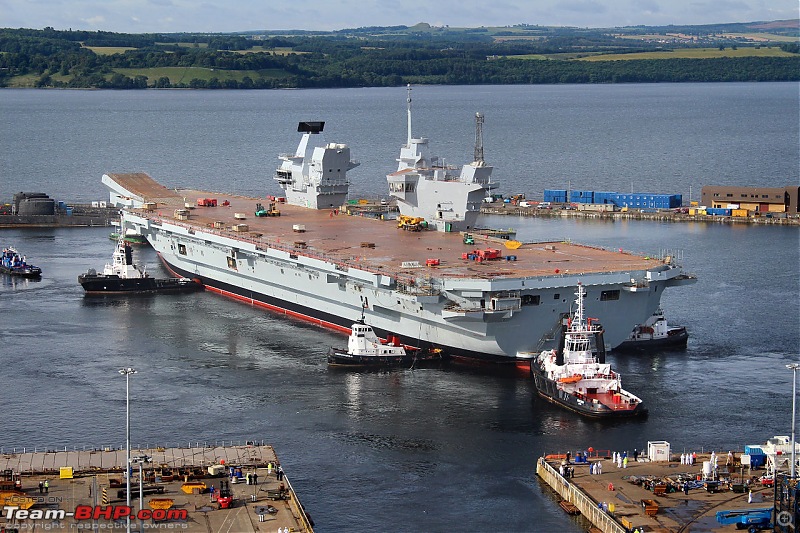
HMS Queen Elizabeth II
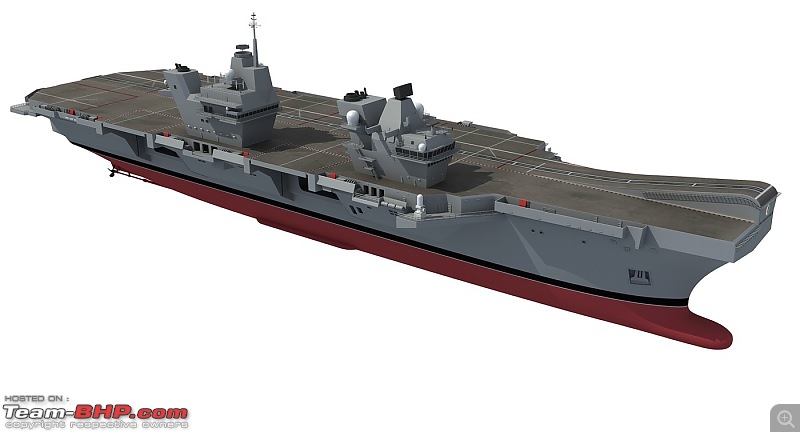
3-D animation
Its an impressive bit of kit. Although I must admit I find the two islands very odd to look at. It almost looks like its photoshopped. I don't think I have seen anything like that yet on a carrier.
Over the years I have had the pleasure of visiting various carriers, mostly museum ships. They are hugely impressive no matter how old. Never got to see the only Dutch carrier, (former British) which was sold to Argentina. It operated one of my all time favourite planes of that era as well. The Grumman Tracker.
Quote:
Originally Posted by Jeroen
(Post 4231325)
Its an impressive bit of kit. Although I must admit I find the two islands very odd to look at. It almost looks like its photoshopped. I don't think I have seen anything like that yet on a carrier.
|
Quote:
Originally Posted by V.Narayan
(Post 4231174)
The Royal Navy believes this improvess efficiency and deck space usage.
|
To me, it looks like the twin towers (one for
Sauron and the other for
Saruman) design is taking up more deck space.
However, the height of the towers look much lower than in a typical aircraft carrier. So perhaps the advantage is in aerodynamics?
Quote:
Originally Posted by V.Narayan
(Post 4231174)
Aircraft Operations: STOBAR (Short Take Off But Arrested Recovery), 13 degree ski-jump, 2 lifts each capable of transferring 2 F-35 fighters simultaneously and uniquely two islands. The forward island is for navigation and the aft for flight operations. The Royal Navy believes this improvess efficiency and deck space usage.
|
Hi,
Why do you think are both the islands facing forward?
Find it strange that between the both, they don't really have great visibility to the rear party of the deck area.
I just expected the rear island to have more windows facing the deck rather than angled towards the front.
Why do you think it is so designed?
Quote:
Originally Posted by V.Narayan
(Post 4231174)
While this is a thread on the Indian Navy's Air Arm I am posting nevertheless on HMS Queen Elizabeth II - the Royal Navy's latest and largest aircraft carrier that commenced on her final sea trials earlier this month. She is a unique ship in many regards - the largest warship ever built for the Royal Navy, the first new ground's up aircraft carrier design in over 30 years (in the world) and the first with the new two island design.
|
Thanks for this Narayan.
For a while I had a feeling that its only We and the Chinese other than the Americans building Aircraft Carriers.
Quote:
Originally Posted by jayakumarkp
(Post 4231344)
Hi,
Why do you think are both the islands facing forward?
Find it strange that between the both, they don't really have great visibility to the rear party of the deck area.
|
It is strange, Especially as landing operations need much more oversight then the take offs. And I have seen many references in various articles that this second tower set up gives so much better visibility, especially for landings.
Jeroen
I would love to know how the tugs were co-ordinated for that carrier manoeuvre.
I think there were ten or eleven of them. It would be tough enough having direct physical control of eleven engines. but to do this, giving second by second and inch by inch commands to each of the tug masters seems impossible.
Quote:
Originally Posted by Jeroen
(Post 4231325)
Although I must admit I find the two islands very odd to look at. I don't think I have seen anything like that yet on a carrier.
|
The two islands design came up due to two reasons - (1) Survivability. They act as back-ups for each other incase one is put out of action (2) The engines deep in the hull of the vessel are spaced far apart. Each set exhausts through one of the two islands. The engines I believe are not placed in adjacent water tight compartments but two (or maybe three) compartments apart. The British I would give credit to having had many firsts in carrier aviation from being the first to fly off a deck, to the first angled decks, to mirror landing sights, steam catapults and finally the ski-jump. So let's wait and watch how successful the 2 island design will be. Who knows others may start imitating them.
Quote:
Originally Posted by jayakumarkp
(Post 4231344)
Hi,
Why do you think are both the islands facing forward?
Find it strange that between the both, they don't really have great visibility to the rear party of the deck area.
|
Both islands will I am sure have 270 degrees or so transparency. We will have to wait till live photos are available with detail.
Quote:
Originally Posted by peterjim13
(Post 4231632)
For a while I had a feeling that its only We and the Chinese other than the Americans building Aircraft Carriers.
|
As an instrument of power projection nothing comes close to a carrier. :thumbs up The Yanks, the Chinese, the British, the French and us are in the carrier business for a long time. Lord Nelson once said, "you cannot buy yourself a Navy, you have to build it." -those were not his exact words but you get the drift. The Italians are in there too with their new 28,000 tonne carrier 'Cavour'. Indirectly the Australian & Spanish are in it through their amphibious docking ships that are Harrier capable.
Quote:
Originally Posted by Thad E Ginathom
(Post 4231656)
I would love to know how the tugs were co-ordinated for that carrier manoeuvre.
but to do this, giving second by second and inch by inch commands to each of the tug masters seems impossible.
|
I don't know much but can only admire them for their art - this and docking a large ship. Almost unbelievable
Quote:
Originally Posted by Thad E Ginathom
(Post 4231656)
I would love to know how the tugs were co-ordinated for that carrier manoeuvre.
I think there were ten or eleven of them. It would be tough enough having direct physical control of eleven engines. but to do this, giving second by second and inch by inch commands to each of the tug masters seems impossible.
|
Actually, war ship, even carriers are relatively not that heavy compared to say merchant ships of the same size. Manoeuvring is all about dead weight and movement/momentum. A tanker or container vessel of this size would in most harbours be assisted by probably four tugs. I have a feeling these are old navy tugs that donít pack much punch. And of course, the Royal Navy probably has an approach of better safe than sorry. More tugs appears safer!
But the control of any number of tugs is actually very straightforward. The pilot or captain will have determined up front how many tugs of how much pulling power they need and where they want them attached. For the actual manoeuvring they will tell them in which direction to pull and how hard! all by means of simple VHF Radio communication.
It is that simple. These days especially on larger vessels they will have a few electronic aids to show them the vessel position very precisely, speed, yaw rates etc.
Modern tugs might be able to tell exactly with how many tonnes they are pulling and can be instructed accordingly. So there is some modern gadgetry involved, but at the end of the day it is down to the experience of one man telling the tugboats what to do.
Itís a real art!
Jeroen
It's an amazing art.
As a small-boat sailor, I know how easy it is to move ten or fifteen tons, with one hand, as long as it is
floating. In fact, I've shouted at people for hauling hard on lines: it's easier to get the thing moving than it is to stop it! I suppose this scales up. Both ways.
Quote:
Originally Posted by V.Narayan
(Post 4231980)
As an instrument of power projection nothing comes close to a carrier. :thumbs up The Yanks, the Chinese, the British, the French and us are in the carrier business for a long time. Lord Nelson once said, "you cannot buy yourself a Navy, you have to build it." -those were not his exact words but you get the drift. The Italians are in there too with their new 28,000 tonne carrier 'Cavour'. Indirectly the Australian & Spanish are in it through their amphibious docking ships that are Harrier capable.
|
Very true. I missed the LPDs the famous Mistral Class !
Egypt got their (made for Russia) Mistrals less than an year ago. We might get our 4 new LPDs in the coming decade.
I think for us to take care of both the Arabian Sea and Bay of Bengal - 2 is a must for our Navy. I do see that we might get the 3rd one the coming decade.
What according to you would be the main role for our 3rd and larger Aircraft Carrier
| All times are GMT +5.5. The time now is 03:32. | |


